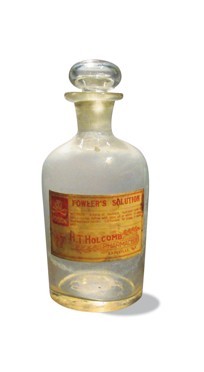Poison Was Everywhere: Arsenic & the Victorians
It’s December. The month of cakes and cookies. But if you’re an avid reader of mysteries and crime novels, even holiday treats may be suspicious…where did that strange spice cake come from anyway?
P.S. Don’t tell Madame Bovary about the wallpaper….
When Poison Was Everywhere
A new book explores how and why arsenic found its way into wallpaper, bread, and baby carriages in Victorian times.
“Slightly over a century ago, poison was a common part of everyday life. Arsenic, the notorious metalloid, was used in all sorts of products, primarily in the inks and aniline dyes of beautifully printed wallpapers and clothing. Odorless and colorless, it went into food as food coloring, and it was used in beauty products, such as arsenic complexion wafers that promised women pure white skin, until as late as the 1920s. It was found in the fabric of baby carriages, plant fertilizers, medicines. It even was taken as a libido pill in Austria.

Fowler’s solution, a health tonic that contained arsenic (Courtesy of the private collection of Madame Talbot)
The literature of the era hints at the effects from arsenic poisoning. The main character in Charlotte Perkins Gilman’s 1892 short story “The Yellow Wallpaper,” for instance, descends into madness and believes that the source of her illness stems from the wallpaper in her room. “It makes me think of all the yellow things I ever saw—not beautiful ones like buttercups, but old foul, bad yellow things,” she says. “But there is something else about that paper—the smell!”
There are numerous studies on William Morris’s arsenic-laden wallpapers, in particular, which were extremely popular during the late 19th century. Morris himself, a designer and artist, was also the heir to the world’s largest copper mine at the time, which produced arsenic dust due to mining activity. Not only did the mine cause massive environmental damage to the land around it, but many miners died of lung disease, according to a 2003 article in Nature. Morris’s famous phrase about the doctors who treated these miners was that they “were bitten by witch fever,” insinuating that the doctors were quacks when they diagnosed arsenic poisonings. He was unwilling to believe the catastrophe his businesses had caused…”
For the rest, click here.
Share
